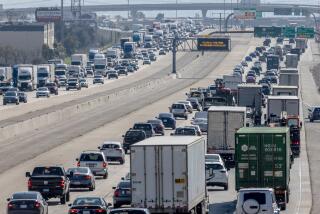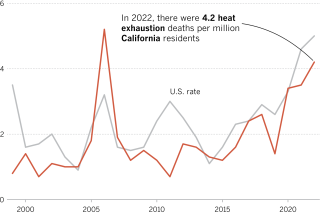High Carbon Monoxide Levels Linked to Rise in Heart Failure Cases
- Share via
A nationwide study has linked carbon monoxide to a rise of nearly 40% in cases of congestive heart failure among elderly Los Angeles County residents on days when the air pollutant reached peak levels.
Los Angeles topped the seven U.S. urban areas analyzed by the researchers, who said that 6,515 cases of congestive heart failure among the elderly in Los Angeles County from 1986 through 1989 were the result of carbon monoxide exposure. That toll amounted 11.3% of congestive heart failure cases in Los Angeles County over that period.
The study, by epidemiologist Dr. Robert D. Morris and co-workers at the Medical College of Wisconsin, is the first to attempt to quantify the heart-disease burden attributable to carbon monoxide.
“Carbon monoxide has been somewhat overlooked in terms of health effects,” Morris said. “What we did was look at a group of people who were very susceptible” to the pollutant. He added, “I don’t know of another study that has done that.”
In the study, published in today’s American Journal of Public Health, the researchers compared daily atmospheric carbon monoxide levels and local hospital records. The pollution data came from the Environmental Protection Agency and the medical data from Medicare, which covered 96% of elderly people admitted to hospitals for heart failure.
They found that on days when ambient carbon monoxide levels peaked, more than the usual number of elderly people were admitted to hospitals for heart failure. Overall, the high carbon monoxide levels increased the heart-failure incidence in Los Angeles County by 37% above the norm. In other words, if there were normally 100 such admissions per day countywide, high carbon monoxide levels could be expected to raise that to 137.
Cliff Gladstein, head of the L.A.-based Coalition for Clean Air, said the new study puts an overlooked health threat in the spotlight. “Historically, we’ve focused pretty much on ozone,” among other pollutants, he said. “We’ve not done as good a job trying to regulate carbon monoxide.”
Medical researchers have long suspected that high levels of ambient carbon monoxide pose a risk to people with heart disease. That is mainly because the pollutant can displace oxygen in the bloodstream, leaving body tissues to suffocate.
In congestive heart failure, the heart muscle continues to pump blood, but not forcefully enough to deliver oxygen-rich blood to all parts of the body.
“People with underlying heart disease are often able to compensate for it,” said Morris. But when they breathe in excess carbon monoxide, “the added stress can be enough to send them to the hospital.”
The other cities that the researchers studied, listed in descending order of the amount of heart failure linked to carbon monoxide, were Chicago and Milwaukee (tied), Detroit, Philadelphia, Houston and New York.
The researchers were surprised to find that carbon monoxide levels did not have to be astronomical to trigger heart failure. Indeed, many of the cases occurred at or below the EPA limit for the pollutant, which is 9.4 parts carbon monoxide per million parts air over an eight-hour period.
Joel Schwartz, an environmental health specialist at the Harvard School of Public Health, said that the new study indicates that the EPA “may have failed to recognize the most serious public health effects of carbon monoxide exposure.”
By far the primary source of atmospheric carbon monoxide is automobile and truck exhaust, Morris said. “There have been efforts to reduce the amount of carbon monoxide,” Morris said. “But it’s not clear how successful those have been.
“Ultimately,” he added, “the solution is to drive less.”
More to Read
Sign up for Essential California
The most important California stories and recommendations in your inbox every morning.
You may occasionally receive promotional content from the Los Angeles Times.













